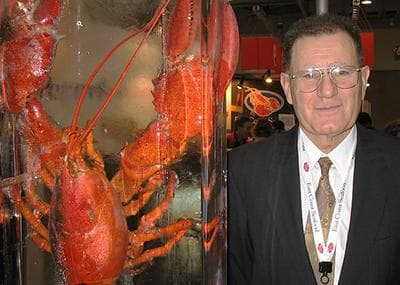Advertisement
The ‘Star’ Of 2009, Seafood Industry Swims Against Economic Tide
ResumeThese days, consumers are looking for value. As a result, fewer people are eating seafood at a restaurant and more are buying it at the grocery store.
And a lot of people bought seafood at the grocery store last year.
"Seafood was sort of the star," said Steve Lutz, executive vice president of the Perishables Group. "It had a very good 2009."

It rose to star status in supermarket aisles as sales grew by 7 percent. Lutz compares that with meat's 2 percent growth and an 8 percent drop-off in restaurant-going. What has been driving seafood supermarket sales, Lutz says, is the perception that a great deal is available.
"Halibut is one of the most expensive per pound items," he said. "It retails at close to $13 a pound. In 2009 halibut did quite well and increased volume because of a reduction of retail price."
Butch Brougher, a consumer researcher for Nielsen, says last year wealthy shoppers bought 78 percent of all seafood, but that is changing.
"The demographics are showing it's appealing to more and more consumers," Brougher said. "I think the lobster story is a huge example of that."
The lobster story is about how a catch that was once perceived as a luxury item has come to "the people." That happened because lobster prices crashed to historic lows last year and it suddenly appeared on more fast-food menus and became greatly discounted in supermarket fish tanks. Lobster saw an 80 percent jump in sales last year.
At the International Boston Seafood Show Tuesday, Spiros Tourkakis pointed to rows and rows of lobster tails in a display case. Tourkakis is the executive vice president of East Coast Seafood, the world’s largest distributor of lobster. He says the price dropped because Maine fishermen caught more fresh lobster while, at the same time, Canadian fisheries put frozen stocks on the market.
"In fact, currently there is a very strong market for frozen product. The reason for that is because the inventory has pretty much been depleted," Tourkakis said.
Seafood's price swings, coupled with the variety of offerings from the sea, make the industry more resilient during a downturn.
"It’s been a wild ride but it’s actually been kind of fun," said Richard Stavis, president of Stavis Seafood, a Boston-based family business that wholesales domestic and imported products. They sold more fish last year than the year before, and cheaper fish sold best.
"People have been able to switch in between species," Stavis said. "That’s one thing that’s allowed seafood to adapt to this environment; you’ve always got a different opportunity out there."
Stavis says you cannot change your offerings as much with chicken and beef. But a restaurant can switch from crab to monkfish if the price is right.
Health benefits are also selling fish. Lutz says consumers rank seafood healthier than beef or chicken.
"Omega-3s are obviously the glamor part of seafood and what’s catching the press, you know that’s the beneficial attribute," Lutz said.
Seafood processors and distributors are optimistic looking ahead, as they predict sales will continue to grow in 2010 — meaning they will continue to reel in profits.
This program aired on March 17, 2010.